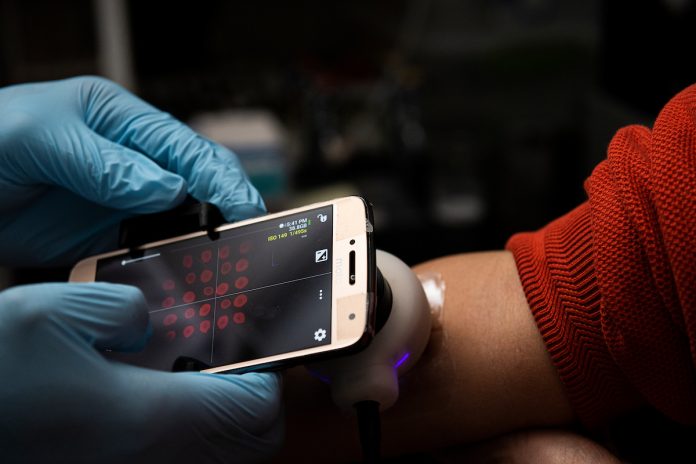
Kim, Chang-Soo from Missouri University of Science and Technology with Stoecker, William V from Stoecker & Associates Technology, Rolla, Missouri, describe a breakthrough smart bandage by S&A Tech and Missouri S&T capable of detecting low tissue oxygen
In the age of digital medicine, a doctor’s ability to image a patient remotely and derive instantaneous and precise physiologic parameters is the basis of many innovations to improve patient health. Smartphones are the common denominator for many of the new applications — the applications utilise the smartphone to gather data for basic clinical parameters such as temperature and heart rate, and increasingly, more advanced clinical parameters to detect diseases earlier. Although emerging technologies can detect diseases from diabetes to skin cancer at an early stage, we still lack early detection for pressure ulcers at a stage before skin breakdown occurs.
Pressure ulcers, also called bedsores, and known in the medical profession as decubitus ulcers, have increased in incidence to the point where they now afflict over 5% of patients in long-term care facilities. Quality of life is abysmal for patients with these painful ulcers, which can take over a year to heal. The expense of healing these ulcers grows in an ageing and increasingly diabetic population, consuming a vast share of medical expenses in developed economies.
The breakthrough smart sensor bandage
To address the need for early ulcer detection, Stoecker & Associates Technologies, a skin biotechnology start-up located in Rolla, Missouri, collaborated with two professors at the Missouri University of Science and Technology (Missouri S&T), also in Rolla, in the Ozark foothills. Professor Chang-Soo Kim, an electrical engineer, specialises in sensor fabrication; Paul Nam, a chemist, has broad experience in biomedical applications. The goal of the team is to develop the first smart sensor bandage capable of detecting low tissue oxygen. This innovation will enable inexpensive continuous monitoring of skin areas prone to pressure ulcers to detect impending ulcers before skin breakdown occurs.
The group developed a simple and low-cost method to fabricate the optical oxygen sensors. The smart bandage functions by an ink cocktail containing an oxygen responsive chemical printed on a disposable bandage. The printing results in an array of sensor dots on a flexible substrate film, the sensor sheet for the bandage. The team developed an automated prototype ink printer to deposit the ink cocktail on the flexible substrate.
The group formulated an ink cocktail with these characteristics: good chemical and physical stability, good adhesion on a sensor sheet, and responsiveness to various levels of oxygen encountered in tissues in a fast, reliable and linear manner. A hydrophilic polymer was used as a medium for dispersion for the oxygen responsive chromophore mixture. The chosen chromophore is the most frequently used fluorophore for the intensity-based optical sensing system. The research reported by the team determined critical variables for the smart bandage. These parameters for optimal cocktail preparation include concentration and particle size of chromophore and base polymer, and a technique to print the sensor dot array on the sensor sheet.
A consumer-grade Android smartphone equipped with a ring of multiple LEDs excited the chromo-phores in the ink cocktail, giving maximum luminescence at the lowest tissue oxygen levels because oxygen quenches the luminescence reaction. The light source gives an incipient blue light in a range near the best response of the ink cocktail. The smartphone captures the image through a 10x macro lens assembly; software filters the raw image to obtain the oxygen sensor response. The photograph above shows the camera and light-source attachment.
The technique of analysing the photophysical dynamics of the oxygen quenching reaction, i.e., how the oxygen level changes the light response of the chemical, is measured by a technique called a Stern-Volmer plot. This graph for our sensor ink dots showed a linear response of the sensors to expected oxygen tissue concentrations found in all possible clinical scenarios. This experiment verified the reliable response of the ink cocktail to the range of oxygen levels encountered in healthy tissue vs. oxygen-depleted tissue prone to ulceration. The response time was determined to be within approximately several minutes, a delay acceptable for a smart bandage utilised for prolonged monitoring. Surprisingly, the cost of the smart bandage will be under one dollar.
Closing thoughts
Since the smart bandage is self-calibrating, no special training is required — the image will contain the information that shows healthy tissue vs. an incipient ulcer. Thus, with no special training, the medical assistant will obtain tissue oxygen measurements as part of a routine patient bed check. For the first time, the nursing staff at a long-term care facility is expected to see an exact map of tissue oxygen levels on an ulcer-prone skin surface. Future work will determine the usefulness of the sensor patches in clinical application. The stability of the patches under different moisture and temperature conditions will be the focus of the clinical work.










